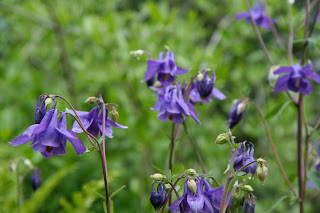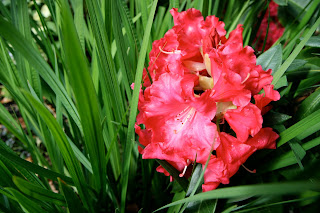Dogwood blossoms
(Cornus 'Eddie's White Wonder')
This is a lovely understory tree for the Deodar Cedar. It has a delicate structure and the flowers light up the shade and contrast with the brightly colored Rhododendrons.
Peruvian Lily
(Alstroemeria 'Red Valley')
I am fond of Alstroemerias but it has taken me years to find a true red one. These were planted last year.
Pacific Coast Iris
Pacific Coast Irises have been hybridized from several Iris species and I have a number of them in various colors throughout our garden. They are easy as pie to grow. They will take sun to light shade and moderate to almost no water in the summer months. They do prefer a well-drained soil so if you have clay (as I do) you will have to add amendments (a rich compost works well). I came into my irises serendipitously when my sons' elementary school was remodeling and they were going to be destroyed. The principal of the school allowed me to dig them out and take them home. They have been moved around several times in my garden and just seem to thrive regardless of what I do. When they are not flowering they look like slumps of coarse grass so I plant them next to plants with contrasting foliage forms.
Siberian Iris
(Iris sibirica 'Caesar's Brother)
These have delicate blossoms and love to wave in the wind. Out of flower, they look like a clumping grass.
Rose
(Rosa 'Valencia')
Columbine- double blossoms with variegated foliage
(Aquilegia 'Leprechaun Gold')
White Bleeding Heart
(Dicentra formosa 'Aurora')
I happen to prefer white flowers to pink (for the most part) so I planted a white bleeding heart. This one has feathery foliage and is spreading happily in this shady nook of the garden.
Spuria Iris
(Iris orientalis
a.k.a. Iris ochroleuca)
I call this the "roadside Iris" because I have seen it growing along roads in solid swaths, especially in the wine country. It grows from 3 to 5 feet tall. Since the flowers are white it can be seen at night and on our road, where there are no street lights, it's an asset. It multiplies like rabbits but still is very attractive.
Lapeirousia cruenta
(a.k.a. Anomatheca laxa)
This is a delicate little flower that scatters itself around but usually finds the bare spots in the garden where little else will grow. It is a corm from Africa. It is an unusual coral color.
Rhododendron 'Burgundy'
Azalea
Japanese maples with Kurume Azaleas. These trees are the lushest they have ever been!
In the back yard, things are also looking lovely.
White Star Creeper
(Laurentia fluviatilis 'Mini White'
a.k.a. Isotoma fluviatilis &
Pratia pedunculata)
This ground cover was planted last fall to fill in the joints between the stepping stones we installed to replace a large area of lawn. With more hard surface we will use less water and the planted joints still give a softness to the garden. I combined White Star Creeper with Blue Star Creeper. The blue flowering form seems to mound more than the white one. I used grape pomace as a mulch when I planted the starts and it worked very well to supply nutrients and keep the soil moist while the plants filled in.
Variegated Flag
(Iris pallida 'Aureo marginata')
Pacific Coast Iris
Variegated Star Jasmine
(Trachelospermum jasminoides 'Summer Sunset')
I'm experimenting with this new variety of Star Jasmine because the colors intrigued me. It is a little tender and almost died to the ground this past winter, but it has leafed out and started to climb this spring. The coloration brightens a shady spot and the flowers still have that heavenly scent.
Black Bearded Iris
(Iris 'Black Dragon')

Foxglove
(Digitalis purpurea)
Flowering Maple & Clematis
(Abutilon 'Paisley' & Clematis 'Ramona')
These are what gardeners call "companion plants". They seem to like growing together. These two intertwine against the fence, in the shade of a Black Oak.
Brass Buttons
(Cotula 'Platt's Black')
An experimental ground cover for me, these sweet little plant is quickly invading but my policy is to allow the strongest species to survive (well, most of the time). The foliage looks like tiny fern fronds, but almost black.
Calla
(Zantedeschia aethiopica)
If you live in northern California and you don't have Callas in your garden, you probably have been using a strong herbicide. These volunteer but I alow them to remain as understory plants where not much else will grow. These are growing under our Black Oaks (Quercus kelloggii).
I also keep them around because one of my goddaughters loves them.
Mr. Mole's mounds
a.k.a. the bane of our garden!
This guy keeps coming through the path from the front to the back garden. We can't seem to smoke him out. He isn't bothering our lawn so I am guessing we have a lot of earthworms (instead of the usual grubs they like).
more to come....






































